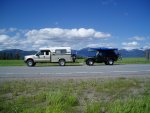RMP&O
Expedition Leader
I am agreeing with Haven's original post. There is definately to big and to small.
Sure you can do it in a 2500lbs SWB super small vehicle but will it be fun, maybe, maybe not. And sure you can do it in a 60,000lbs million dollar truck. Will you be living like a king out there? Without a doubt but you will also be severly limited in where you can go.
Everybody has their own ideas. If you usually just go out into the deserta nd camp then by all means to small and to large may both work fine. In heavily wooded areas, jungle, rocks and the mountians to big or to small is not going to work very well at all.
Then you have the whole arond the world overland travel thing. In this case to small is definately better then to large. Fr example, try navigating that 60,000lbs rig through Latin Streets that are about 12ft wide. Make a wrong turn, come to a dead end and spend 4hrs getting it turned around! Or it is to tall and you gte hung up on some of those low hanging power lines. None of those kinds of things would I want to deal with.
For long range multi use around the world travel, there is defiantely an ideal size of the truck.
cheers
Sure you can do it in a 2500lbs SWB super small vehicle but will it be fun, maybe, maybe not. And sure you can do it in a 60,000lbs million dollar truck. Will you be living like a king out there? Without a doubt but you will also be severly limited in where you can go.
Everybody has their own ideas. If you usually just go out into the deserta nd camp then by all means to small and to large may both work fine. In heavily wooded areas, jungle, rocks and the mountians to big or to small is not going to work very well at all.
Then you have the whole arond the world overland travel thing. In this case to small is definately better then to large. Fr example, try navigating that 60,000lbs rig through Latin Streets that are about 12ft wide. Make a wrong turn, come to a dead end and spend 4hrs getting it turned around! Or it is to tall and you gte hung up on some of those low hanging power lines. None of those kinds of things would I want to deal with.
For long range multi use around the world travel, there is defiantely an ideal size of the truck.
cheers


